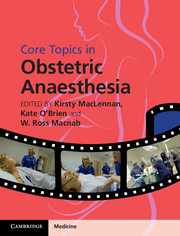Book contents
- Frontmatter
- Contents
- List of contributors
- Preface
- Section 1 Basic science, epidemiology and service organization
- Section 2 Obstetric aspects
- Section 3 Provision of anaesthesia
- Section 4 Medical conditions in pregnancy
- 14 Hypertension in pregnancy, pre-eclampsia and eclampsia
- 15 Sepsis and influenza in pregnancy
- 16 Cardiac disease in pregnancy
- 17 Respiratory disease in pregnancy
- 18 Obesity and ultrasonography for central neuraxial blocks
- 19 Endocrine disease in pregnancy including diabetes mellitus, thyroid and adrenal disease
- 20 Renal disease
- 21 Haematologic disease in pregnancy
- 22 Neurosurgical and neurological disease in pregnancy
- 23 Immunology, including testing and management of allergy during pregnancy
- 24 HIV and infectious disease in pregnancy, including herpes, syphilis and hepatitis
- Section 5 Postpartum complications and obstetric emergencies
- Section 6 Service organization
- Index
- Plate section
- References
17 - Respiratory disease in pregnancy
from Section 4 - Medical conditions in pregnancy
Published online by Cambridge University Press: 05 December 2015
- Frontmatter
- Contents
- List of contributors
- Preface
- Section 1 Basic science, epidemiology and service organization
- Section 2 Obstetric aspects
- Section 3 Provision of anaesthesia
- Section 4 Medical conditions in pregnancy
- 14 Hypertension in pregnancy, pre-eclampsia and eclampsia
- 15 Sepsis and influenza in pregnancy
- 16 Cardiac disease in pregnancy
- 17 Respiratory disease in pregnancy
- 18 Obesity and ultrasonography for central neuraxial blocks
- 19 Endocrine disease in pregnancy including diabetes mellitus, thyroid and adrenal disease
- 20 Renal disease
- 21 Haematologic disease in pregnancy
- 22 Neurosurgical and neurological disease in pregnancy
- 23 Immunology, including testing and management of allergy during pregnancy
- 24 HIV and infectious disease in pregnancy, including herpes, syphilis and hepatitis
- Section 5 Postpartum complications and obstetric emergencies
- Section 6 Service organization
- Index
- Plate section
- References
Summary
Introduction
A number of significant physiological changes occur within the maternal respiratory system throughout pregnancy, either as a result of hormonal or neonatal effects. Chapter 1 details these changes.
Asthma
Asthma is a common condition characterized by intermittent reversible airways obstruction, chronic inflammation of the airways and bronchospasm. It affects approximately 5% of the population in the UK and is more common in women than men.
Asthma may be affected by pregnancy. Meta-analysis has shown approximately one-third of women will have improved symptoms, one-third will worsen and one-third will see no changes. Any worsening of symptoms will typically peak at six months gestation. There is often an improvement of symptoms during labour, perhaps due to endogenous corticosteroid production, with acute asthma being very rare at this stage.
Well-controlled asthma is unlikely to have any impact on the pregnancy. Uncontrolled asthma is associated with a variety of complications, including hyperemesis, hypertension, pre-eclampsia, vaginal haemorrhage, complicated labour, fetal growth restriction, preterm birth, increased perinatal mortality and neonatal hypoxia. Large cohort studies have shown an increased caesarean section rate in those with moderate and severe asthma.
Treatment should be optimized during pregnancy. A large case-controlled study showed no increased risk of congenital malformations in mothers being treated for asthma. There is good evidence that the older therapies have no teratogenic effects and no evidence to show the newer agents cause any harm. The risk of uncontrolled asthma is far greater than the theoretical risk of therapy.
Acute asthma should be managed in the standard way. Poor management is associated with poor outcomes for mother and fetus; there is no known risk to the fetus with standard treatment.
Asthma is not a contraindication to any form of labour analgesia. Should caesarean section be required, regional anaesthesia is suitable, as those with asthma are less likely to tolerate mechanical ventilation well.
Postpartum haemorrhage can safely be managed with syntometrine and prostaglandin E2. Prostaglandin F2α may cause bronchospasm.
Breastfeeding is not a contraindication to any of the treatments given for asthma, none of which are found in dangerous levels in the milk. Oral steroids may also be given safely to the breastfeeding mother.
- Type
- Chapter
- Information
- Core Topics in Obstetric Anaesthesia , pp. 123 - 129Publisher: Cambridge University PressPrint publication year: 2015



